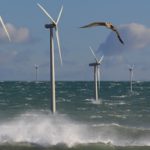Like a lot of Americans who work in clean energy, I worried coming into the election about what a Trump presidency might mean for our industry and all of the public benefits it provides.
Candidate Trump, after all, railed at rallies that renewable energy “is not working so good.” He complained about solar’s payback time. Of wind power, which now supplies about 5 percent of the country’s electricity, employs 88,000, including more than 21,000 in manufacturing, and, in a growing number of places, is the least expensive form of new generating capacity available.
Short-Term Good
Now that the election has come and gone, I can’t say I’ve learned to stop worrying and love the bomb. But I can tell you I think Donald Trump will be good for clean energy in the short term at the least, lighting a fire under project developers who are pretty nervous about possible changes in federal policy and incentives. That’s the case even though two key drivers of clean-energy deployment, the federal Investment Tax Credit and the Production Tax Credit, have strong, bipartisan support and are thus unlikely to be repealed since they already are scheduled to sunset over the next several years.
The efforts of developers across the country will likely bump up the rest of the supply chain — manufacturing, distribution, and construction — faster than we first anticipated. Think wind power before the 2014 expiration of the federal Production Tax Credit. That amped-up deployment can, in turn, help us solidify important industry trends and gains we’ve seen in recent years, including precipitous price declines, increased investment in research and new technologies, and more competition in the marketplace. All these can make wind and other clean energy more accessible to customers big and small and can make it a bigger player in the American industrial landscape.
Unintended Catalyst
With Donald Trump’s election as an unintended catalyst, our industry can continue to create more jobs, cut more carbon pollution from our energy supply, help our kids breathe increasingly cleaner air, and lower energy costs for everyone. That’s true no matter what the president-elect has said about global warming.
We should take this opportunity and run with it.
I know we’re at an especially historic moment because of what our organization hears from the companies we work with as recruiters. “Since the election, we are operating in a policy environment for renewable energy in which the medium to long term is unclear at best,” notes Jon Rappe, senior vice president of renewable project developer ImMODO Energy Services. With good state and federal policies currently in place, at least for now, “we are staffing up and trying to get as many projects as possible in the ground before any new administration policies may take effect.”
Going Full Throttle
It’s not just ImMODO that feels this way. One overseas renewable developer expanding into the U.S. market has told us to go full throttle on hiring now. Before the election, he had a slower schedule.
Another industry source, Brian Hill, the general manager of Bachmann said, “Our primary focus in the U.S. wind energy market is on operating assets, and those aren’t going anywhere soon, no matter who is in office.
I expect our plans to support these wind farms will lead to additional work for contract technicians, project managers, and engineers. Regarding the overall growth in the wind, I believe the momentum of the industry would be very difficult to reverse at this point, especially in light of the price of wind energy compared to other sources, and recent trends of corporations such as Google, Amazon, and Microsoft securing large contracts for renewable energy. This continued growth should lead to manufacturing jobs throughout the OEM production chain.”
Another industry insider, Benoy Thanjan of Reneu Energy, notes that much of “the growth in solar and wind has been driven by state-level policies and incentives and steep price declines in building projects. These two drivers are probably not going to stop.”
Indeed, for 2015, wind and solar ranked No. 1 and No. 2 in terms of new electric generating capacity brought online, outpacing natural gas and other sources despite significant price drops for fossil fuels.
America Loves Clean Energy
This new growth can help us mature as an industry, but it can also do more than that. The American public already loves clean energy by overwhelming margins. That’s true not just of Clinton fans but Trump supporters, too. Seventy-seven percent of them favor wind power, and 88 percent like utility-scale solar. We should highlight the benefits we bring to the nation, like wind-sector job growth of 20 percent in 2016 or solar job growth that has averaged more than 20 percent per year over the last six years. Or how our industries can offer those without college degrees middle-class incomes, rather than the low-wage jobs that are too often their only other alternatives.
We should highlight that investment in renewable energy boosts local economies and creates jobs in the U.S. that cannot be outsourced such as construction, transportation, operations, and maintenance.
Accelerating Transition
We should talk up the more than 500 wind-power component manufacturers we have in 43 states. These next few years are the time we should use to press our advantages with policymakers in Washington. They have an enormous impact on our industry’s growth and our ability to deliver the public benefits of clean energy that make us so proud.
Donald Trump’s electoral college victory is not something many of us in the clean-energy community thought would benefit our industry and the country and planet it serves. But we can use the next few years to do what we do best: accelerate the transition to a clean energy future.
Especially with our industry working as advocates, the idea that a Trump presidency can put a stop to clean-energy growth just might be the biggest hoax of all.


































